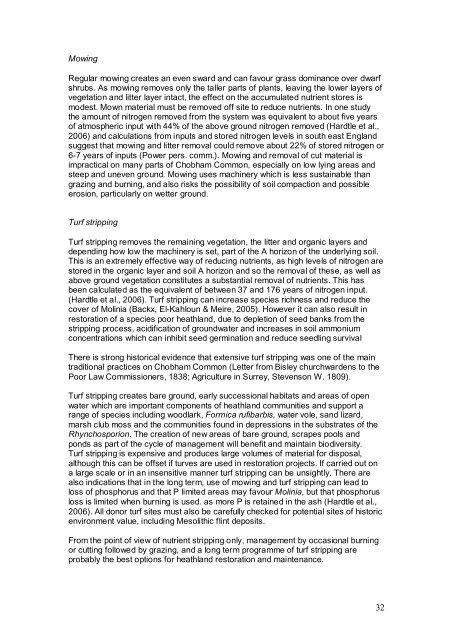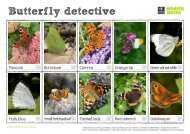CHOBHAM COMMON NNR - Surrey Wildlife Trust
CHOBHAM COMMON NNR - Surrey Wildlife Trust
CHOBHAM COMMON NNR - Surrey Wildlife Trust
Create successful ePaper yourself
Turn your PDF publications into a flip-book with our unique Google optimized e-Paper software.
Mowing<br />
Regular mowing creates an even sward and can favour grass dominance over dwarf<br />
shrubs. As mowing removes only the taller parts of plants, leaving the lower layers of<br />
vegetation and litter layer intact, the effect on the accumulated nutrient stores is<br />
modest. Mown material must be removed off site to reduce nutrients. In one study<br />
the amount of nitrogen removed from the system was equivalent to about five years<br />
of atmospheric input with 44% of the above ground nitrogen removed (Hardtle et al.,<br />
2006) and calculations from inputs and stored nitrogen levels in south east England<br />
suggest that mowing and litter removal could remove about 22% of stored nitrogen or<br />
6-7 years of inputs (Power pers. comm.). Mowing and removal of cut material is<br />
impractical on many parts of Chobham Common, especially on low lying areas and<br />
steep and uneven ground. Mowing uses machinery which is less sustainable than<br />
grazing and burning, and also risks the possibility of soil compaction and possible<br />
erosion, particularly on wetter ground.<br />
Turf stripping<br />
Turf stripping removes the remaining vegetation, the litter and organic layers and<br />
depending how low the machinery is set, part of the A horizon of the underlying soil.<br />
This is an extremely effective way of reducing nutrients, as high levels of nitrogen are<br />
stored in the organic layer and soil A horizon and so the removal of these, as well as<br />
above ground vegetation constitutes a substantial removal of nutrients. This has<br />
been calculated as the equivalent of between 37 and 176 years of nitrogen input.<br />
(Hardtle et al., 2006). Turf stripping can increase species richness and reduce the<br />
cover of Molinia (Backx, El-Kahloun & Meire, 2005). However it can also result in<br />
restoration of a species poor heathland, due to depletion of seed banks from the<br />
stripping process, acidification of groundwater and increases in soil ammonium<br />
concentrations which can inhibit seed germination and reduce seedling survival<br />
There is strong historical evidence that extensive turf stripping was one of the main<br />
traditional practices on Chobham Common (Letter from Bisley churchwardens to the<br />
Poor Law Commissioners, 1838; Agriculture in <strong>Surrey</strong>, Stevenson W. 1809).<br />
Turf stripping creates bare ground, early successional habitats and areas of open<br />
water which are important components of heathland communities and support a<br />
range of species including woodlark, Formica rufibarbis, water vole, sand lizard,<br />
marsh club moss and the communities found in depressions in the substrates of the<br />
Rhynchosporion. The creation of new areas of bare ground, scrapes pools and<br />
ponds as part of the cycle of management will benefit and maintain biodiversity.<br />
Turf stripping is expensive and produces large volumes of material for disposal,<br />
although this can be offset if turves are used in restoration projects. If carried out on<br />
a large scale or in an insensitive manner turf stripping can be unsightly. There are<br />
also indications that in the long term, use of mowing and turf stripping can lead to<br />
loss of phosphorus and that P limited areas may favour Molinia, but that phosphorus<br />
loss is limited when burning is used. as more P is retained in the ash (Hardtle et al.,<br />
2006). All donor turf sites must also be carefully checked for potential sites of historic<br />
environment value, including Mesolithic flint deposits.<br />
From the point of view of nutrient stripping only, management by occasional burning<br />
or cutting followed by grazing, and a long term programme of turf stripping are<br />
probably the best options for heathland restoration and maintenance.<br />
32



![Thursley Common [Shrike Hill] (SU9041) & Sheets Heath (SU9457 ...](https://img.yumpu.com/11846073/1/184x260/thursley-common-shrike-hill-su9041-sheets-heath-su9457-.jpg?quality=85)

